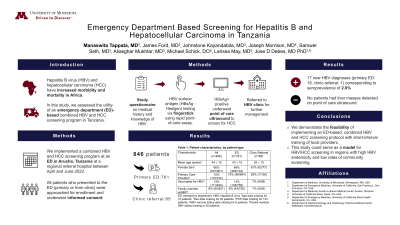Monday Poster Session
Category: Liver
P2378 - Emergency Department Based Screening for Hepatitis B and Hepatocellular Carcinoma in Tanzania
Monday, October 23, 2023
10:30 AM - 4:15 PM PT
Location: Exhibit Hall

Has Audio
- MT
Manaswita Tappata, MD
University of Minnesota
Minneapolis, MN
Presenting Author(s)
Manaswita Tappata, MD1, James Ford, MD2, Johnstone Kayandabila, MD3, Joseph Morrison, 4, Samwel Seth, MD3, Aliasghar Mukhtar, MD3, Michael Schick, DO5, Larissa May, MD5, Jose Debes, MD, PhD1
1University of Minnesota, Minneapolis, MN; 2University of California, San Francisco, San Francisco, CA; 3Arusha Lutheran Medical Center, Arusha, Arusha, Tanzania; 4University of California Davis, Davis, CA; 5University of California Davis Health, Sacramento, CA
Introduction: Hepatitis B virus (HBV) and hepatocellular carcinoma (HCC) have increased morbidity and mortality in Africa in part due to lack of detection of HBV and lack of surveillance programs for HCC. In this study, we assessed the utility of an emergency department (ED)-based combined HBV and HCC screening program in Tanzania.
Methods: We implemented a combined HBV and HCC screening program at an ED in Arusha, Tanzania at a regional referral hospital between April and June 2022. All patients who presented to the ED (primary or from clinic) were approached for enrollment. They underwent informed consent and completed a study questionnaire. HBV testing was conducted via fingerstick using a rapid point-of-care assay to detect HBV surface antigen (HBsAg). Patients who were HBSAg positive underwent point of care ultrasound to screen for HCC, and were referred to HBV clinic for further management. Local ED and critical care providers with ultrasound experience were trained on how to systematically screen the liver for masses. We measured the number of HBV diagnoses (primary outcome) and the number of liver masses (secondary outcome). Data were analyzed with descriptive statistics.
Results: A total of 846 patients were tested for HBV during the study period (primary ED: 761, clinic-referral: 85). Median age of patients was 44 ± 15 years, and 66% were female. Only 15% of patients had a primary care doctor, and 13% of patients had been previously vaccinated for HBV. For questionnaire results, 65% of patients did not know how HBV is transmitted, and 6% of patients had a family member with a known HBV infection. There were 17 new HBV diagnoses (primary ED: 16, clinic-referral: 1), which corresponds to a seroprevalence of 2.0% [95% CI 1.2, 3.2]. No patients had liver masses detected on point of care ultrasound.
Discussion: We demonstrate the feasibility of implementing an ED-based, combined HBV and HCC screening protocol with short-interval training of local providers. This study could serve as a model for HBV/HCC screening in regions with high HBV endemicity and low rates of community screening.
Disclosures:
Manaswita Tappata, MD1, James Ford, MD2, Johnstone Kayandabila, MD3, Joseph Morrison, 4, Samwel Seth, MD3, Aliasghar Mukhtar, MD3, Michael Schick, DO5, Larissa May, MD5, Jose Debes, MD, PhD1. P2378 - Emergency Department Based Screening for Hepatitis B and Hepatocellular Carcinoma in Tanzania, ACG 2023 Annual Scientific Meeting Abstracts. Vancouver, BC, Canada: American College of Gastroenterology.
1University of Minnesota, Minneapolis, MN; 2University of California, San Francisco, San Francisco, CA; 3Arusha Lutheran Medical Center, Arusha, Arusha, Tanzania; 4University of California Davis, Davis, CA; 5University of California Davis Health, Sacramento, CA
Introduction: Hepatitis B virus (HBV) and hepatocellular carcinoma (HCC) have increased morbidity and mortality in Africa in part due to lack of detection of HBV and lack of surveillance programs for HCC. In this study, we assessed the utility of an emergency department (ED)-based combined HBV and HCC screening program in Tanzania.
Methods: We implemented a combined HBV and HCC screening program at an ED in Arusha, Tanzania at a regional referral hospital between April and June 2022. All patients who presented to the ED (primary or from clinic) were approached for enrollment. They underwent informed consent and completed a study questionnaire. HBV testing was conducted via fingerstick using a rapid point-of-care assay to detect HBV surface antigen (HBsAg). Patients who were HBSAg positive underwent point of care ultrasound to screen for HCC, and were referred to HBV clinic for further management. Local ED and critical care providers with ultrasound experience were trained on how to systematically screen the liver for masses. We measured the number of HBV diagnoses (primary outcome) and the number of liver masses (secondary outcome). Data were analyzed with descriptive statistics.
Results: A total of 846 patients were tested for HBV during the study period (primary ED: 761, clinic-referral: 85). Median age of patients was 44 ± 15 years, and 66% were female. Only 15% of patients had a primary care doctor, and 13% of patients had been previously vaccinated for HBV. For questionnaire results, 65% of patients did not know how HBV is transmitted, and 6% of patients had a family member with a known HBV infection. There were 17 new HBV diagnoses (primary ED: 16, clinic-referral: 1), which corresponds to a seroprevalence of 2.0% [95% CI 1.2, 3.2]. No patients had liver masses detected on point of care ultrasound.
Discussion: We demonstrate the feasibility of implementing an ED-based, combined HBV and HCC screening protocol with short-interval training of local providers. This study could serve as a model for HBV/HCC screening in regions with high HBV endemicity and low rates of community screening.
Disclosures:
Manaswita Tappata indicated no relevant financial relationships.
James Ford indicated no relevant financial relationships.
Johnstone Kayandabila indicated no relevant financial relationships.
Joseph Morrison indicated no relevant financial relationships.
Samwel Seth indicated no relevant financial relationships.
Aliasghar Mukhtar indicated no relevant financial relationships.
Michael Schick indicated no relevant financial relationships.
Larissa May indicated no relevant financial relationships.
Jose Debes indicated no relevant financial relationships.
Manaswita Tappata, MD1, James Ford, MD2, Johnstone Kayandabila, MD3, Joseph Morrison, 4, Samwel Seth, MD3, Aliasghar Mukhtar, MD3, Michael Schick, DO5, Larissa May, MD5, Jose Debes, MD, PhD1. P2378 - Emergency Department Based Screening for Hepatitis B and Hepatocellular Carcinoma in Tanzania, ACG 2023 Annual Scientific Meeting Abstracts. Vancouver, BC, Canada: American College of Gastroenterology.
